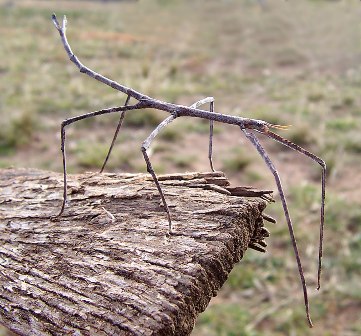Masters of Mimicry
Isaiah 40:28
Hast thou not known? hast thou not heard, that the everlasting God, the LORD, the creator of the ends of the earth, fainteth not, neither is weary? there is no searching of his understanding.
Though they are only insects, stick insects seem to have an amazing knowledge of their surroundings. They are geniuses at using their predators’ weakness for their own protection.
 Stick insects are leaf eaters. Many of them look like little twigs. The longest insect in the world is a walking stick from Borneo that reaches a length of 13 inches. A tropical stick is as thick as a finger and the same color as the bamboo on which it is often found. It also has swollen ridges that make it look even more like bamboo. Other types have leafy flaps that match the leaves of the plants they frequent. Some stick insects go even further. They lay eggs that look exactly like the seeds of the plant on which they feed. A stick that’s found in New Mexico glues its eggs to grass stems. The position and shape of the long pointed eggs exactly mimic the seeds of that species of grass.
Stick insects are leaf eaters. Many of them look like little twigs. The longest insect in the world is a walking stick from Borneo that reaches a length of 13 inches. A tropical stick is as thick as a finger and the same color as the bamboo on which it is often found. It also has swollen ridges that make it look even more like bamboo. Other types have leafy flaps that match the leaves of the plants they frequent. Some stick insects go even further. They lay eggs that look exactly like the seeds of the plant on which they feed. A stick that’s found in New Mexico glues its eggs to grass stems. The position and shape of the long pointed eggs exactly mimic the seeds of that species of grass.
While they don’t fly, some sticks have brightly colored wings that they can rapidly unfurl. They use this ability to startle away nervous birds who might want to investigate them for lunch. Sticks will often sway with the breeze to make their illusion more effective. Some sticks will sit motionless for hours. Some birds understand this and will closely examine non-moving twigs. Sticks will often refuse to move even when being carried away by a bird. This tactic has fooled many birds into thinking it really was a twig and releasing it.
Stick insects are clearly not the result of mindless chance. Their intelligence was created by the Creator of the universe.
Prayer:
Dear Lord, I can never thank You enough that You are the Creator and in charge of the universe. Many in our world do not know this and live in hopelessness. Help us to reach them in their hopelessness with Your good news. Amen.
Notes:
Sivinski, John. 1992. “When is a stick not a stick?” Natural History, June, p. 30. Photo: The stick insect Ctenomorpha chronus. (CC BY-SA 3.0)